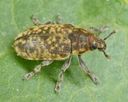Rhinocyllus
Rhinocyllus
Classification
- Phylum: Arthropoda
- Subphylum: Hexapoda
- Class: Insecta
- Order: Coleoptera
- Suborder: Polyphaga
- Superfamily: Curculionoidea
- Family: Curculionidae
- Subfamily: Lixinae
- Tribe: Rhinocyllini
- Genus: Rhinocyllus
Pronunciation
How to pronounce Rhinocyllus: /rɪnoʊˈsɪləs/
These audio files are automatically generated. While they are not always 100% accurate, they are a good starting point.
Images






Summary
Rhinocyllus is a genus of small true weevils, primarily associated with thistle plants, used in biological pest control, particularly R. conicus. Its distribution spans Europe, North Africa, Asia, and has expanded to North America following intentional introduction.
Physical Characteristics
Small true weevils, typically exhibiting elongated bodies characteristic of the Curculionidae family.
Identification Tips
Identification can be made based on body shape, size, and the specific morphological traits of each species, particularly R. conicus.
Habitat
Primarily found in areas where thistles grow; associated with thistles in the subtribe Carduinae.
Distribution
Native to southern and central Europe, North Africa, and western Asia; now widespread in the United States and adjacent Canada due to introduction for weed control.
Diet
Herbivorous; primarily feeds on host plants in the subtribe Carduinae, notably noxious thistles.
Life Cycle
Life cycle details are specific to species but generally include egg, larval, pupal, and adult stages, often with larvae feeding on host plants.
Reproduction
Oviposition is typically on or near host plants; details on specific mating rituals or reproductive behaviors are not provided.
Ecosystem Role
Acts as a biological control agent for noxious thistles, impacting plant community dynamics.
Economic Impact
Intentionally introduced for weed control; its impact can be both positive (pest control) and negative (potential harm to non-target species).
Cultural Significance
Noted for its role in biological pest control; R. conicus is particularly controversial.
Collecting Methods
- Sweep netting in thistle habitats
- Visual inspection of host plants for adult specimens
Preservation Methods
- Drying specimens
- Using ethanol for preservation
Evolution
Rhinocyllus is closely related to the genus Bangasternus, sharing a sister group relationship.
Similar Taxa
Misconceptions
Some may confuse R. conicus for being purely beneficial without acknowledging the ecological risks associated with its introduction.
Tags
- weevil
- biological control
- thistle pest
- Rhinocyllus